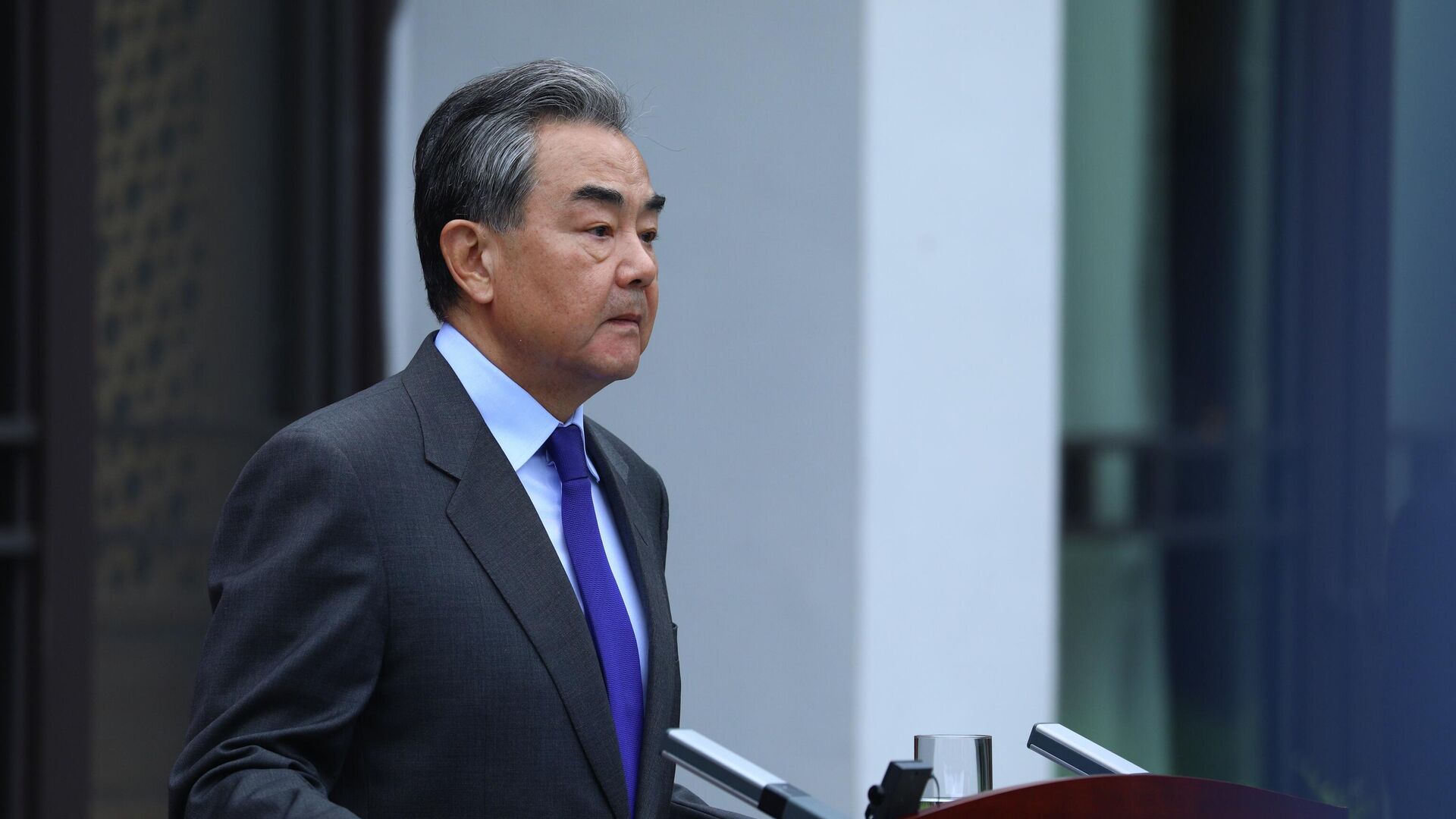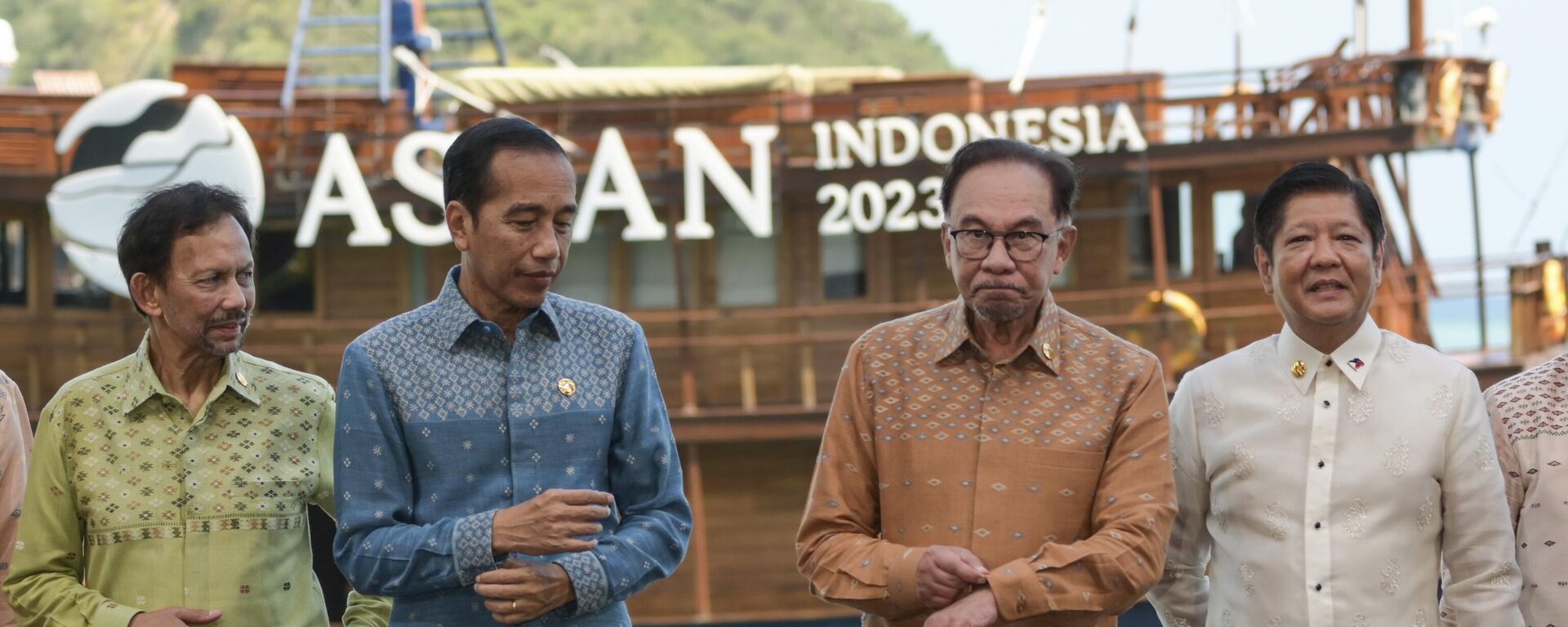https://sputnikglobe.com/20230809/wang-yi-to-visit-three-southeast-asian-states-after-south-china-sea-showdown-with-philippine-navy-1112491823.html
Wang Yi to Visit Three Southeast Asian States After South China Sea Showdown With Philippine Navy
Wang Yi to Visit Three Southeast Asian States After South China Sea Showdown With Philippine Navy
Sputnik International
Chinese Foreign Minister Wang Yi will visit three Southeast Asian nations next week, the ministry said on Wednesday. The trip comes amid a feud with the Philippines over a submerged coral reef in the South China Sea.
2023-08-09T18:02+0000
2023-08-09T18:02+0000
2023-08-09T18:02+0000
asean
wang yi
china
south china sea
trade ties
strategic stability
asia
philippines
chinese foreign ministry
https://cdn1.img.sputnikglobe.com/img/07e6/05/1b/1095830372_0:0:3073:1728_1920x0_80_0_0_e54b7ba9ea7eaf8b2249859fe7494202.jpg
The Chinese Foreign Ministry said in a statement that Wang’s visit to Singapore, Malaysia, and Cambodia next week aims to “strengthen strategic communication with the three Southeast Asian countries.”The three nations are all members of the Association of Southeast Asian Nations (ASEAN), a 10-nation bloc that doesn’t include China but with which it has a close relationship. Since 2020, ASEAN has been China’s biggest trading partner, and nearly every member state is also both part of China’s Belt and Road Initiative and a signatory to the Regional Comprehensive Economic Partnership (RCEP). That trade bloc is the world’s largest, encompassing roughly 30% of the world’s population and 30% of its gross domestic product.However, the visit comes just days after China and another ASEAN member, the Philippines, clashed over control of a submerged coral reef in the South China Sea.Over the weekend, Chinese Coast Guard ships used their water cannons to drive off a pair of Philippine Navy supply ships near Second Thomas Shoal, located about 121 miles west of the Philippine island of Palawan. The ships were attempting to resupply a contingent of troops posted on the rusting derelict hull of what had once been the BRP Sierra Madre, a World War II-era transport ship that Manila deliberately grounded on the reef in 1999 in order to raise it above the high tide line.However, China and the Philippines aren’t the only countries with overlapping claims on the myriad of islands and reefs in the South China Sea: so do Vietnam, Malaysia, and Brunei.For nearly two decades, China and ASEAN have worked to make a document for governing interactions in the waterway to avoid escalation. Last month in Jakarta, the 11 nations held their second reading of the so-called Code of Conduct, and the working group pledged to complete the work within three years.“It’s in the common interests of ASEAN whether the overall integration and regional cooperation can be effectively maintained, and the security and military confrontation between China and the United States in the South China Sea can be prevented from escalating,” he added.Other dynamics are likely also at play in Wang’s trip, however. Late last month, Singapore, Thailand, Indonesia, and Malaysia rolled out a new program allowing citizens of any of the countries to make payments using any of the four nations’ currencies using a QR-code-based digital wallet. It’s a major move toward regional economic integration that foregoes exchanges through either the US dollar or Chinese yuan.
https://sputnikglobe.com/20230807/china-to-philippines-remove-illegally-grounded-warship-from-disputed-reef-1112448711.html
https://sputnikglobe.com/20230511/whats-in-the-way-marcos-seeks-finalization-of-south-china-sea-code-of-conduct-at-asean-1110271689.html
china
south china sea
philippines
Sputnik International
feedback@sputniknews.com
+74956456601
MIA „Rossiya Segodnya“
2023
News
en_EN
Sputnik International
feedback@sputniknews.com
+74956456601
MIA „Rossiya Segodnya“
Sputnik International
feedback@sputniknews.com
+74956456601
MIA „Rossiya Segodnya“
south china sea; wang yi; philippines; singapore; cambodia, malaysia; asean
south china sea; wang yi; philippines; singapore; cambodia, malaysia; asean
Wang Yi to Visit Three Southeast Asian States After South China Sea Showdown With Philippine Navy
Chinese Foreign Minister Wang Yi will visit three Southeast Asian nations next week, the ministry said on Wednesday. The trip comes amid a feud with the Philippines over a submerged coral reef in the South China Sea, but also moves toward increased regional economic integration.
The Chinese Foreign Ministry said in a statement that Wang’s visit to Singapore, Malaysia, and Cambodia next week aims to “strengthen strategic communication with the three Southeast Asian countries.”
“China is also willing to work with the three countries … to promote economic recovery, maintain peace and tranquility, and deepen exchanges and mutual learning, as well as making greater contributions to peace, stability, development and prosperity for the region and the world,” the ministry added.
The three nations are all members of the Association of Southeast Asian Nations (ASEAN), a 10-nation bloc that doesn’t include China but with which it has a close relationship. Since 2020, ASEAN has been China’s biggest trading partner, and nearly every member state is also both part of China’s Belt and Road Initiative and a signatory to the Regional Comprehensive Economic Partnership (RCEP). That trade bloc is the world’s largest, encompassing roughly 30% of the world’s population and 30% of its gross domestic product.
However, the visit comes just days after China and another ASEAN member, the Philippines, clashed over control of a submerged coral reef in the South China Sea.
Over the weekend, Chinese Coast Guard ships used their water cannons to drive off a pair of Philippine Navy supply ships near Second Thomas Shoal, located about 121 miles west of the Philippine island of Palawan. The ships were
attempting to resupply a contingent of troops posted on the rusting derelict hull of what had once been the BRP Sierra Madre, a World War II-era transport ship that Manila deliberately grounded on the reef in 1999 in order to raise it above the high tide line.
Manila protested, calling China’s actions provocative, while Beijing said its forces acted in a legal and orderly manner to defend their claims over the reef. The US has thrown its weight behind Manila, with which it has a mutual defense treaty.
However, China and the Philippines aren’t the only countries with overlapping claims on the myriad of islands and reefs in the South China Sea: so do Vietnam, Malaysia, and Brunei.
For nearly two decades, China and ASEAN have worked to make a document for governing interactions in the waterway to avoid escalation. Last month in Jakarta, the 11 nations held their second reading of the so-called Code of Conduct, and the working group pledged to complete the work within three years.
“The situation in the South China Sea actually affects the future regional security and economic development of the entire Asia-Pacific region,” Zhu Feng, an international relations professor at Nanjing University, was quoted as saying in Chinese media.
“It’s in the common interests of ASEAN whether the overall integration and regional cooperation can be effectively maintained, and the security and military confrontation between China and the United States in the South China Sea can be prevented from escalating,” he added.
Other dynamics are likely also at play in Wang’s trip, however. Late last month, Singapore, Thailand, Indonesia, and Malaysia rolled out a new program allowing citizens of any of the countries to make payments using any of the four nations’ currencies using a QR-code-based digital wallet. It’s a major move toward regional economic integration that foregoes exchanges through either the US dollar or Chinese yuan.






